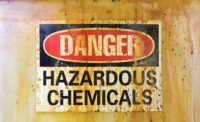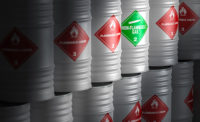Most chemical safety issues fall under the subject of "hazard communication." OSHA's Hazard Communication standard (OSHA 29 CFR 1910.1200), which in many ways has become "the mother of all safety regulations" and ranks high among OSHA citations, is comprehensive because it applies wherever there is any kind of hazardous chemical.
The potential for injury and illness due to improper storage, handling and exposure of hazardous chemicals and materials is great, especially for industrial and manufacturing workers. OSHA estimates that more than 32 million workers are exposed to 650,000 hazardous chemical products each year. This makes effective hazard communication vital to workplace safety, and an accurate, comprehensive hazard communication program is essential for most industrial and manufacturing companies.
What's your type?
To better understand effective hazard communication, you must know the types of chemical-related hazards workers may encounter in the workplace. There are three primary types of chemical-related hazards: fire and explosion hazards, reactivity hazards and health hazards.1) Fire and explosion hazards. Many chemicals, depending on their makeup and composition, have the potential to ignite easily and also explode under changing conditions such as pressure and temperature. The flash point is the temperature at which a chemical or substance will ignite. Tests can determine a product's flash point. For example, in a fire test using paint thinner - a common flammable liquid - the paint thinner ignited easily and the fire spread rapidly. Another controlled test used a chemical with a potential explosion hazard - ordinary aerosol paint. Under certain conditions, the igniting of common cans of aerosol paint can cause intense fire and explosion.
2) Reactivity hazards. Some chemicals have the ability to react violently when mixed with other chemicals. These chemical reactions may produce toxic gases, fire and explosion. An example of reactivity is the mixing of brake fluid and chlorine. The chemical reaction of these two products is usually quite violent, even though there is no fire source present. Often reactivity hazards are encountered accidentally when chemicals spill or when a person unknowingly brings two reactive substances together.
3) Health hazards. Found in various forms, a health hazard refers to a chemical's ability to cause immediate or long-term health effects after an exposure. Types of health hazards include irritants, sensitizers, corrosives and toxics. Let's discuss these different forms of health hazards in more detail:
- Irritants. These are chemicals that cause rashes or inflammation at the point of contact. Examples include gasoline, mineral spirits, acids, caustic soaps, concentrated cleaners, paints, stains, oils and grease.
- Sensitizers. These are chemicals that can cause allergic reactions after repeated exposure, similar to the way people may react to repeated bee stings. When using chemicals that are sensitizers, some people will experience a more severe reaction each time they are exposed. Examples include adhesive products and turpentine.
- Corrosives. These have the potential to cause redness, inflammation, irritation and even severe burns depending on the duration of exposure, the corrosive strength of the product and the sensitivity of the individual exposed. Examples include battery acid, drain cleaners, bleach and certain detergents.
- Toxics. These are substances that can cause short-term or long-term health effects or are suspected of causing cancer, disease or injury under certain conditions. Examples include antifreeze, pesticides and various types of degreasers, as well as certain adhesives.
Get it in writing
OSHA requires all employers to develop a written hazard communication plan. An important element of that plan is employee training. What's entailed in training? According to the Hazard Communication standard, training must:
- inform employees of the identity, nature and hazards of chemicals in their workplace;
- teach workers how to recognize potential chemical-related hazards; and
- show them how to work safely with chemicals.
An effective chemical safety program incorporates a variety of work environments and engaging, high-end graphics to clearly explain the components of the OSHA Hazard Communication standard. Compre-hensive training should include information such as how to understand labeling systems and material safety data sheets (see sidebar), safe handling practices for a variety of hazardous materials, recognizing differences between common hazardous materials, and how to reduce or eliminate exposure.
When seeking to implement or improve a hazard communications program, quality training materials that promote best safety practices and provide the necessary tools and information to protect yourself and your workers are needed. Information is your most valuable tool when working with, or around, hazardous chemicals.
Shouldering responsibility
The process of identifying chemical-related hazards from products that you work with starts with the information provided by the manufacturer. Chemical manufacturers are responsible for evaluating their products to determine if they have chemical-related hazards. However, it's your workers' responsibility to understand how to use the information provided and recognize the potential hazards of the products they work with or around, and to follow established safe work practices.
Effective training will enable your workers to readily recognize and understand the potential hazards of the products they use each day - and take action to protect their safety and health, as well as the safety and health of their coworkers.
SIDEBAR: Proper ID required
The first line of defense in preventing chemical incidents is having all containers of hazardous chemicals labeled with the proper identification. The process of identifying hazards starts with the information provided by the manufacturer, which is responsible for evaluating its products to determine if they have any chemical-related hazards. This information is used to produce the container label and a material safety data sheet (MSDS) for the product.Label
- written in English
- legible (not smeared)
- prominently located on the container
- contains warnings indicating the type and classification of the chemical hazard associated with the product
MSDS
- document prepared by the manufacturer providing detailed product information
- maintained at the unit, or available via intranet or through a toll-free 800 number
- provides, at a minimum, precautionary information in these critical areas: product identification, hazardous ingredients, physical and chemical characteristics, fire and explosion data, reactivity information, health hazards data, the use of personal protective equipment (PPE)

